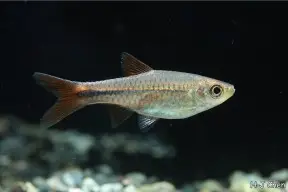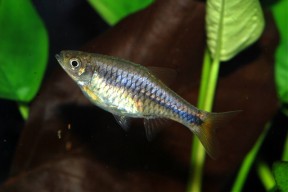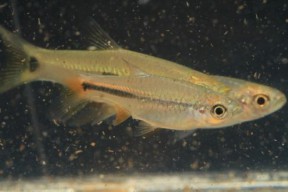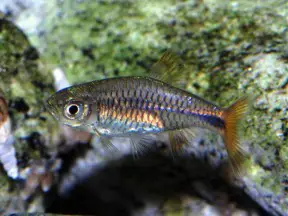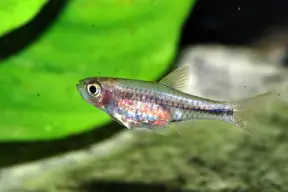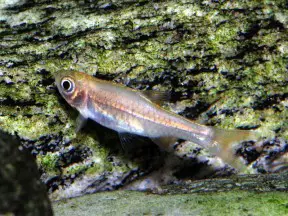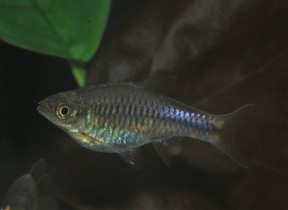Rasbora lacrimula
Red Cherry Rasbora
Classification
Cyprinidae
Distribution
The only confirmed record is from the type locality in the Ulu (river) Belayan drainage, part of the lower Mahakam drainage in Kalimantan Timur (east Kalimantan), Indonesian Borneo. It may have a larger distribution in that area given its appearance in the aquarium trade.
Habitat
The type locality is within an oil palm plantation and the habitat heavily-modified with the fish themselves collected from a “gutter” as well as small streams running through open ground. The area was previously forested but burned to the ground during 1997 and 1998 with secondary forest cover now established outside the plantation.
The streams in which the species was discovered are generally 2-3 metres wide, less than 1 m deep and contain clear water flowing slowly over substrates of sand, clay and mud. The pH was measured to be “about 5”.
Maximum Standard Length
25 – 31 mm.
Aquarium SizeTop ↑
A tank with base dimensions of 45 cm x 30 cm or more should suffice.
Maintenance
Choice of décor is not especially critical although this species tends to show better colouration when maintained in a well-planted set-up with a dark substrate, or naturalistic arrangement with roots, branches and leaf litter. The addition of some floating plants to diffuse the light entering the tank also seems to be appreciated and adds a more natural feel. Filtration does not need to be particularly strong as it mostly hails from sluggish waters but the water must be free of organic pollutants.
Water Conditions
Temperature: 72 – 78°F/22.2 – 25.6°C
pH: 4.0 – 7.5
Hardness: 1 – 12°H
Diet
Likely to be a micropredator feeding on small insects, worms, crustaceans and other zooplankton in nature. In the aquarium it will accept dried foods of a suitable size but should not be fed these exclusively. Daily meals of small live and frozen fare such as Daphnia, Artemia and suchlike will result in the best colouration and encourage the fish to come into breeding condition.
Behaviour and CompatibilityTop ↑
This species is very peaceful indeed making it an ideal resident of the well-furnished community tank. As it places no special demands in terms of water chemistry it can be combined with many of the most popular fish in the hobby including other small cyprinids as well as tetras, livebearers, rainbowfish, anabantoids, catfish and loaches. As always when selecting a compatible community of fish thorough research is essential and its small adult size must be a consideration. A community based around species from .
It’s a schooling species by nature and really should be kept in a group of at least 8-10 specimens. Maintaining it in decent numbers will not only make the fish less nervous but will result in a more effective, natural-looking display. Males will also display their best colours as they compete with one other for female attention.
Sexual Dimorphism
Adult males tend to be noticeable slimmer, smaller and more intensely-coloured than females.
Reproduction
Like many small cyprinids this species is an egg-scattering, continuous spawner that exhibits no parental care. That is to say when the fish are in good condition they will spawn often and in a densely-planted, mature aquarium it is possible that small numbers of fry may start to appear without intervention.
However if you want to increase the yield of fry a slightly more controlled approach is required. The adult group can still be conditioned together but one or more long, shallow, say 30″ x 12″ x 12″/75cm x 30cm x 30cm/71 litre containers should also be set up and half-filled with water. These should be very dimly lit and the base covered with some kind of mesh of a large enough grade so that the eggs can fall through it but small enough so that the adults cannot reach them. The widely available plastic ‘grass’-type matting can also be used and works very well. The water itself should be of slightly acidic to neutral pH with a temperature towards the upper end of the range suggested above. A small power filter can be added initially and this should be positioned so that the flow is directed down the full length of the tank.
When the adult fish are well-conditioned and the females appear full of eggs one or two pairs should then be introduced to each container. Spawning can be initiated by adding small amounts of cool water every few hours in such a way that the tank is gradually topped up and feeding small amounts of live and frozen foods. Several spawning events will usually occur before a female is spent with 5 to 12 eggs being produced each time and a typical batch consisting of 30 to 50.
The adults will eat any eggs they find and are best removed after a couple of days at which point the power filter should be switched for a mature sponge-type unit in order to avoid fry being sucked into the mechanism. Incubation is temperature-dependant to an extent but usually takes between 18 and 48 hours with the young free-swimming 24 to 48 hours later. Initial food should be Paramecium or similar introducing Artemia nauplii and/or microworm once the fry are large enough to accept them.
NotesTop ↑
This species is also traded as ‘Bornean redfin rasbora’, ‘sunshine rasbora’ and ‘dwarf volcano rasbora’ and first appeared in the hobby during the latter part of 2010. It can be told apart from all other members of the genus by a combination of the following characters: possession of small tubercules on the dorsal surface, posterior to the dorsal fin and continuing onto the upper part of caudal fin, visible as an irregular ‘crest‘ when a specimen is viewed laterally; a few tubercules on the lower edge of the caudal fin; colour pattern consisting of a faint, dark midlateral stripe ending in a relatively large, horizontally-orientated, teardrop-shaped blotch at the caudal peduncle.
The tubercules on the dorsal surface of the body and caudal fin may be indicative of sexual maturity as they’re not present in smaller specimens. The only other Rasbora species to possess such tubercules is R. tuberculata but in that species they’re also distributed in front of the dorsal fin and on the dorsal fin itself.
Rainboth’s ‘Fishes of the Cambodian Mekong’ characterised members of Rasbora by possession of an unbranched, non-spiny first dorsal fin ray and seven soft dorsal rays, origin of the dorsal fin in the middle of the body, five branched anal fin rays, a small mouth not extending below the eye and a lack of barbels. It’s long been recognised as a polyphyletic lineage as noted by Kottelat (1999) amongst others, and in 2010 the results of a phylogenetic analysis by T. Y. Liao et al. suggested a number of changes in order to improve the taxonomy. The authors found species of rasborin genera to actually represent a monophyletic grouping existing in six clades and erected four new genera (all containing former members of Rasbora) in order to preserve monophyly of the existing groups i.e. Boraras, Horadandia, Rasbora, Rasboroides and Trigonostigma.
According to the authors the first two clades are monotypic; R. brittani should now be referred to as Kottelatia brittani and R. dorsiocellata as Brevibora dorsiocellata. The third clade comprises Boraras brigittae, Horadandia atukorali, Rasboroides vaterifloris, Trigonostigma heteromorpha and three species previously included in Rasbora but also moved into new genera; Trigonopoma gracile, T. pauciperforatum and Rasbosoma spilocerca. The results for B. brigittae and T. heteromorpha were found to be inconclusive in some respects and further work regarding their phylogenetic position was recommended.
The fourth clade includes Rasbora semilineata, R. borapetensis, R. rubrodorsalis and an undescribed fish similar to R. beauforti. Clade five consists of R. daniconius, R. hubbsi, R. paucisqualis, R. wilpita, R. kobonensis, R. ornata and R. cf. daniconius. Clade six, meanwhile, is subdivided into two groupings. The first contains R. einthovenii, R. elegans and R. cephalotaenia and the second R. lateristriata, R. argyrotaenia, R. volzii, R. paviana, R. rasbora (plus an undescribed, similar fish), R. caudimaculata and R. trilineata. As this final clade contains the type species (see below) its members retain the generic name Rasbora as do clade five species because they don’t differ sufficiently to warrant a the erection of a new genus/genera.
Unfortunately many species weren’t included in the analysis, meaning inevitable questions are raised regarding the correct placement of the 40 or so other Rasboras, in particular. As the genus had previously been split into various ‘species groups’ (groups of closely-related species) dating back to Brittan (1972, who referred to them as ‘species complexes’) Liao et al. proposed the following arrangement whilst noting it may be subject to change with further phylogenetic studies:
R. semilineata species group: R. semilineata, R. borapetensis, R. rubrodorsalis.
R. trifasciata species group: R. trifasciata, R. amplistriga, R. api, R. bankanensis, R. dies, R. ennealepis, R. hubbsi, R. johannae, R. kluetensis, R. meinkeni, R. nodulosa, R. paucisqualis, R. rutteni, R. sarawakensis, R. taytayensis, R. tobana, R. truncata, R. tuberculata.
R. daniconius species group: R. daniconius, R. armitagei, R. dandia, R. kobonensis, R. labiosa, R. microcephalus, R. ornata, R. wilpita.
R. einthovenii species group: R. einthovenii, R. cephalotaenia, R. elegans, R. jacobsoni, R. kalochroma, R. kottelati, R. nematotaenia, R. patrickyapi, R. tubbi.
R. argyrotaenia species group: R. argyrotaenia, R. aprotaenia, R. aurotaenia, R. baliensis, R. borneensis, R. bunguranensis, R. dusonensis, R. evereti, R. hobelmani, R. hossi, R. lateristriata, R. laticlavia, R. leptosoma, R. philippina, R. septentrionalis, R. spilotaenia, R. steineri, R. tawarensis, R. tornieri, R. volzii.
R. sumatrana species group: R. sumatrana, R. atridorsalis, R. calliura, R. caudimaculata, R. dorsinotata, R. notura, R. paviana, R. rasbora, R. subtilis, R. trilineata, R. vulgaris.
Not classified: R. beauforti, R. chrysotaenia, R. gerlachi (validity in question), R. lacrimula (said to compare most closely with R. dies and R. semilineata which are members of the R. trifasciata and R. semilineata groups, respectively) R. kalbarensis, R. reticulata, R. vulcanus (possibly not Rasboras) and R. zanzibarensis (identity in question).
NB – this list has been amended from that published in Liao et al. to reflect subsequent new species descriptions and taxonomical changes.
Shortly afterwards a paper investigating systematics of the subfamily Danioninae was published by Tang et al. (2010) Their results differed wildly from those of Liao et al. and the four new genera plus Boraras and Trigonostigma were synonymised with Rasbora based on an incomplete knowledge of relationships within the group, an approach they describe as ‘more conservative’. Though perhaps neither conclusion is satisfactory we decided to adopt the system of Liao et al. pending future studies, if only because we prefer to retain Boraras and Trigonostigma.
The identity of the type species, often given as R. rasbora in the past, is no longer in question; when Bleeker first referred to the name Rasbora in 1859 only four nominal members were included of which R. cephalotaenia (known as Leuciscus cephalotaenia at the time) should be considered the type. Howes (1980) suggested the separation of a number of species into the new genus Parluciosoma with type species P. (Rasbora) argyrotaenia but the monophyly of that grouping was not recovered by Liao et al..
References
- Brittan, M. R. 1972 - T. F. H. Publications: 1-224
A revision of the Indo-Malayan fresh-water fish genus Rasbora. - Hadiaty, R. K. and M. Kottelat. 2009 - Ichthyological Exploration of Freshwaters 20(2): 105-109
Rasbora lacrimula, a new species of cyprinid fish from eastern Borneo (Teleostei: Cyprinidae). - Kottelat, M. 1999 - Raffles Bulletin of Zoology 47(2): 591-600
Nomenclature of the genera Barbodes, Cyclocheilichthys, Rasbora and Chonerhinos (Teleostei: Cyprinidae and Tetraodontidae), with comments on the definition of the first reviser. - Liao, T. Y., Kullander, S. O. and F. Fang. 2010 - Zoologica Scripta 39: 155-176
Phylogenetic analysis of the genus Rasbora (Teleostei: Cyprinidae). - Mayden, R. L., K. L. Tang, K. W. Conway, J. Freyhof, S. Chamberlain, M. Haskins, L. Schneider, M. Sudkamp, R. M. Wood, M. Agnew, A. Bufalino, Z. Sulaiman, M. Miya, K. Saitoh and S. He. 2007 - Journal of Experimental Zoology (Molecular and Developmental Evolution) 308B: 1–13.
Phylogenetic relationships of Danio within the order Cypriniformes: a framework for comparative and evolutionary studies of a model species. - Tang, K. L., M. K. Agnew, W. J. Chen., M. V. Hirt, T. Sado, L. M. Schneider, J. Freyhof, Z. Sulaiman, E. Swartz, C. Vidthayanon, M. Miya, K. Saitoh, A. M. Simons, R. M. Wood and R. L. Mayden. 2010 - Molecular Phylogenetics and Evolution 57(1): 189-214
Systematics of the subfamily Danioninae (Teleostei: Cypriniformes: Cyprinidae).

